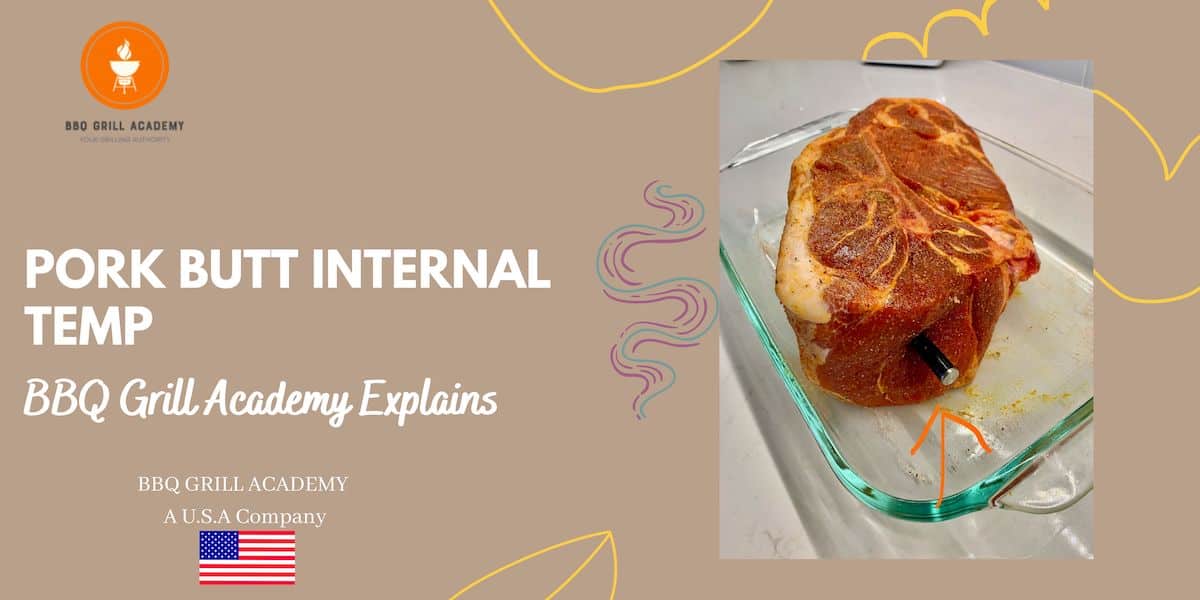One of the most mouthwatering BBQ dishes is made with pork butt. Despite its name, pork butt is derived from the pork shoulder. It is juicy and tender, and when cooked or smoked with the right wood at the proper temperature, it is delicious.
The perfect pork temp is between 195 and 200 degrees Fahrenheit for best results in tenderness, juiciness, and texture. However, you must “hit” important internal temperatures throughout the cooking process to ensure that the pork butt is on point.
Pork Butt Internal Temperature
The USDA recommends cooking pork to 145 degrees for safety and to kill bacteria, but BBQ pitmasters bring pork butt to 195 to 200 degrees to break down collagen into gelatine and connective tissue for the most tender pork butt.
Cuts containing a great deal of collagen and connective tissue, such as pork shoulder, must be cooked thoroughly and preferably slowly for the collagen and connective tissue to break down and yield a tender pork butt.
Large pork cuts, such as pork shoulders (pork butt), are often cooked low and slow to allow the connective tissue to break down, rendering fat to ensure a moist, juicier pork.
If you cook a boston butt (yes, another name for pork butt) too quickly, the exterior of the meat will cook, but the interior will not reach 200 degrees, at least not without the exterior layer of meat being burned or dried.
On top of dried pork,cooking a boston butt too fast will not render fat properly and will not have a good texture.
Optimal cooking temperatures for pork butt
Low and Slow: 225°F

There are several advantages to smoking pork butts at 225 degrees Fahrenheit, including increased smoke exposure. This is my preferred and “go to” temperature whenever I want a perfectly smoked pork butt, prepare smoked pulled pork or simply have the time for proper slow cooking.
Cooking at this temperature allows the smoke to permeate the meat and add flavor. When cooking at this temperature, allow approximately one hour to one hour and thirty minutes per pound of meat for the fat to render and the meat to be tender.
Using a pellet grill or smoker or a charcoal smoker are two great ways to achieve these low temperatures and infuse meat with ample smoke. There are a variety of grills that can be set up to operate at these temperatures.
Pellet smokers and drum smokers are the easiest to use at low temperatures and are easy to set and maintain a consistent cooking temperature. For flavor, nothing beats a charcoal smoker or an offset smoker, but if you’re creative enough, a standard charcoal grill will suffice.
How long will it take to cook pork butt at 225°F?
The time it takes to smoke a pork butt depends on conditions like the type of smoker, cut of meat, and type of fuel. However, a good rule of thumb is to smoke pork butts for about one hour to one hour and thirty minutes per pound. Smoking it at 225, you will be leaning more towards the one hour and a half mark.
So if you bought a small five-pound pork butt, your total cooking time would be about 7.5 hours.
225°F adds more smoke.
Smoking a pork butt at 225 degrees will add more smoke since the meat will be in the smoker longer. You certainly want to spritz it with a spray bottle with apple juice or apple cider vinegar to keep it moist. Meat can dry out even when smoking it at low temperatures.
Pork Butt at 275°F – Low to Medium Heat
Another commonly used temperature for smoking meat is 275 degrees, which can speed up the smoking process. However, you must closely monitor the tenderness of the meat. When cooking at a higher temperature, you can use butcher paper to wrap the pork and keep it from drying while pushing the internal temperature. You can also use heavy duty foil to wrap the meat.
It is important to always use a meat thermometer or an instant read thermometer to make sure the internal temp is on point and where it needs to be. Because of pork rub and other seasonings used to smoke pork butt, it can look done on the outside, but you can very well have raw meat still inside.
Pork Butt at 300°F – Hot and faster
Not everyone has the patience or time to cooking butts for a few hours. This is when cooking on direct heat can reduce the cook time substantially. High temperatures are common when cooking Cuban-style pork roast, where the meat has a tougher consistency and connective tissues are not broken down as much because the roast will be carved into chunks.
Still, it is important to hit a target temperature of at least 200 degrees. Also use a good dry rub, if possible, apple wood to add rich flavor. When making pulled pork, it is best to smoke the cut low and slow to achieve maximum tenderness and easily pull the meat apart.
I like to trim excess fat since cooking at high temps might not allow big chunks of fat to render well and I also like to use plenty of BBQ rub to enhance flavor.
One tip is to be careful not to burn the meat’s skin or small tips. BBQ seasoning is known for having brown sugar, which can start caramelizing at high temperatures.
Tips for achieving the right pork butt temps

Prep the pork for the smoker, Trim and Season
Before even considering dipping your meat in a bath of delicious barbecue sauce, you must begin with a solid foundation, which consists of trimming and preparing the meat. For making tasty pulled pork and the best pulled pork, it is important to trim excess fat, small pieces of meat that will burn, and any silver skin that can also burn.
I like to season the meat and let it rest in the fridge for at least an hour before putting it in the smoker.
Preparing the smoker
The second thing you want to do is prepare the smoker. I cannot count the number of times, during my learning and testing years, that I became distracted and forgot to preheat, clean, and preheat the smoker. Always preheat your smoker, clean it, and then set it to the desired temperature.
I also like to use a small water pan during long cooks to make sure the meat stays moist. Make sure you have plenty of charcoal, smoking pellets, and barbecue tools handy.
COOK TO TEMPERATURE, NOT BY Guessing TIME
Wife: “Honey, when will the food be ready?” Me:” when the thermometer says it is!”
The point here is that even after years of smoking meat, visual cues can be useless here because the meat will look ready due to all the smoke and seasoning. Always use a meat thermometer to monitor the cooking process and make sure you hit those target temps.
I like using smart thermometers like the MeatStick because I can set alerts and walk away. I get alerts when the meat stalls and when is ready. Talking about the stall!
WATCH FOR THE STALLING
Use a reliable thermometer to monitor the temperature, and keep an eye out for the stall. Large meat cuts tend to slow down and sometimes come to a stop because it takes a lot of heat to get deep inside the meat and increase the internal temperature.
If you wait long enough, the meat will eventually start cooking again. However, the problem is that while doing so, you are exposing the outside of the meat to excess heat and cooking time, which can dry out the meat.
This is when wrapping the meat comes in handy. When you warp the meat, it will cook in its own juices, guarding the outside while the inside gets to its target temp.
Let it Rest
before grabbing your preferred meat carving knife and beginning to carve the meat. Let it rest. Allowing the meat to rest for at least 30 minutes to an hour will allow it to finish cooking and increase those few degrees, as well as allow all of the juices to return to the meat for juicy cuts.
Free BBQ tips
Spitzing
Spriting meat during long cooking sessions prevents it from drying out and keeps it moist. You can spritz the meat every 30 minutes.
Keeping the pork butt warm
You can keep the pork in aluminum foil to keep it warm, but you can also use a cooler to keep it warm before it is time to cut, slice, and deep in your favorite BBQ sauce.
Pork Butt and Pork Shoulder
You’ve probably heard of the cut names pork shoulder and pork butt. The pork shoulder is the primal cut. That is, it is the primary cut from the pig’s carcass. The shoulder yields to subprimal cuts, the pork butt or boston butt, and the picnic shoulder or roast.
One last word
For optimal results, the pork should be cooked to a temperature of at least 200 degrees Fahrenheit, despite the fact that there are a number of other critical temperature targets to meet. If you are smoking the meat low and slow, aim for 1 and a half hours per pound. I hope you found this guide useful.
Enjoy.






